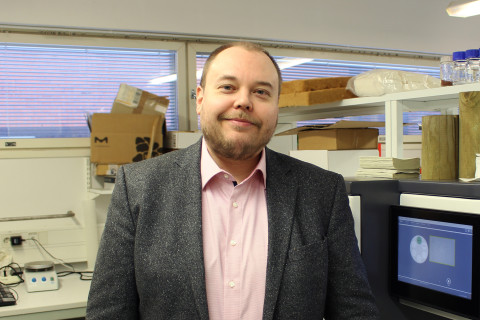Wood materials science is present in our daily life, even though we don’t always recognise it.
Wood refining runs in some families. Following in the footsteps of his father, Professor of Wood Materials Science and Technology Antti Haapala entered the wood processing sector at the age of 16, when he started working in a UPM paper mill in Kajaani.
“During my university years in Oulu, I spent more time at paper mills in Kajaani and Oulu than in the lecture rooms, but I did manage to complete my MSc in engineering in four years, after I found my own field and switched my major from computer sciences. Collaboration with forest sector companies and technology suppliers was close also when I was studying for my doctorate, and since then my research topics have become increasingly diverse and my networks of collaboration increasingly international.”
“For me, February 2022 is a rather memorable month not only because of the ongoing and escalating international conflict, but also because it marked the endpoint of my tenure track and an Olympic gold for Finland in ice hockey, which I’ve been waiting for since the ‘88 Winter Olympics in Calgary,” says Haapala, a big fan of Finland’s national ice hockey team.
The research and education group on wood materials science was established in the Faculty of Science and Forestry in 2013. Haapala has been a key driver of its development since summer 2014, when he was appointed as a tenure track Assistant Professor.
Earlier, Haapala worked as a researcher at the University of Oulu, focusing on wood fibre processing and biocomposites. During his years in Joensuu, collaboration across departmental boundaries has always been central to his work.
“We have sought to integrate expertise related to wood processing and wood products into research and education in forest sciences. In addition to forestry, our research takes place in the interfaces shared by biology, environmental science, chemistry and physics research,” Haapala says.
Identifying new properties of and new usage potential for forest biomass, and creating opportunities for climate-smart material applications, are at the core of wood materials science. The aim of technological and scientific advances is to enable new uses for wood. In education and research, the technical potential of wood and various sustainability perspectives shake hands quite naturally.
“It is difficult to find a more diverse field. The forest industry and the chemicals industry are the industrial reference groups for wood materials science and technology. There are plenty of different emotions and opinions both for and against the use of wood; these are usually not directed at the material properties of wood, but emphasise the societal significance of the sector,” Haapala says.
Haapala also refers to a recent statement by the Finnish historian Teemu Keskisarja: “Finland lives from, in, and is, a forest.”
“The most visible cornerstone of our economic history in people’s everyday life is wood. In the built environment, this means wood materials that cover surfaces and support walls and ceilings, as well as versatile fibre products that we wear and wipe with,” Haapala says.
The scale will be further expanded by various bioenergy products, biocarbon, chemicals separated from wood and its by-streams in industrial processing, and various nanomaterials. The forest is also seen for the trees – for example, the properties of fungi and the chemistry of berries, among other things, are being studied in different materials technology applications.
“There are endless new opportunities for wood, either as such or as part of various hybrid combinations. Usually, the debate is more about the profitability of business cases than about the performance of materials. Whether we are talking about biocomponents of diesel fuel, or element solutions in construction, wood should be seen as an enabling factor rather than as a complete solution in itself.”
Wood research constantly finds new needs
Structural changes and trends in the forest industry are reflected in research into wood materials science. As the role of the print media continues to decline, and the role of various fibre packaging and wood construction solutions expands, we are faced with a more diverse selection of potential uses of wood than ever before. New application areas and product innovations are being developed by a broad scientific community both here in Finland and abroad.
“The aim of wood materials science is to be widely involved in various development projects and to introduce its expertise to the field’s companies and education. Our group has contributed to the establishment of a regional R&D hub in the wood sector together with Natural Resources Institute Finland and Karelia University of Applied Sciences. The group has also secured competitive Academy of Finland funding for a project examining the effects of climate change on the materials used in wood construction, as well as for a study that evaluates the transmission of viruses from wooden surfaces.”
“Our industrial projects pertain to the development of wood preservatives and the manufacture of nanocellulose products. There are also many grant projects that take creative research approaches at the interfaces between chemistry, nutrition, health, materials science and wood.”
According to Haapala, basic research contributions emphasise the interaction between wood and other materials, such as water, fire, fungi, or consumers. Applied research requires laboratory work, testing of prototypes, biorefining and other space and equipment-intensive activities.
Demand for wood sector experts is visible in the labour market
The University of Eastern Finland’s soon-to-launch Master’s degree programme in technology under the theme Sustainable Materials and Products has a strong focus on industrial processing of wood materials. It is forecast that there will be an increasing demand in industry for experts who master both measurement technology, data analysis and wood properties alike.
“Whether the intention is to manufacture ecological textiles, speciality chemicals or long-lived construction products from wood, multidisciplinary expertise and comprehensive IT-skills will be needed. Together with industry, we strive to develop a unique competence module for this theme.”
Haapala is pleased to note that the forest industry isn’t and hasn’t been regarded as a sunset industry for a long time now. Despite cyclical fluctuations, there is demand for forest sector experts in the labour market.
“Young people will see that wood, paper, cardboard and many other material derivatives are not going out of fashion, nor can be easily digitalised. There is a need for materials experts also in the future, and any talks of a sunset industry are rather misguided.”
For further information, please contact:
Antti Haapala, [email protected], tel. +358 44 520 2849, https://uefconnect.uef.fi/en/person/antti.haapala/
Print-quality photos available at photo1 and photo2
***
Professor of Wood Materials Science and Technology, University of Eastern Finland 1 Feb 2022–
Mid Sweden University, FSCN Research Centre, Visiting Professor in Chemical Engineering 1 Feb 2022– 31 Jan 2025
MSc (Process Engineering) 2005, University of Oulu
DSc (Process Engineering) 2010, University of Oulu
MSc (Management and Organization) 2012, University of Oulu, Oulu Business School
Title of Docent, Applied Physics 2016 (Wood-based bioeconomy, fibre-derived applications), University of Eastern Finland
Key roles
Associate Professor (tenure track), University of Eastern Finland 2018–2022
Assistant Professor (tenure track), University of Eastern Finland 2014–2018
Post-doc researcher, University of Oulu 2011–2014



